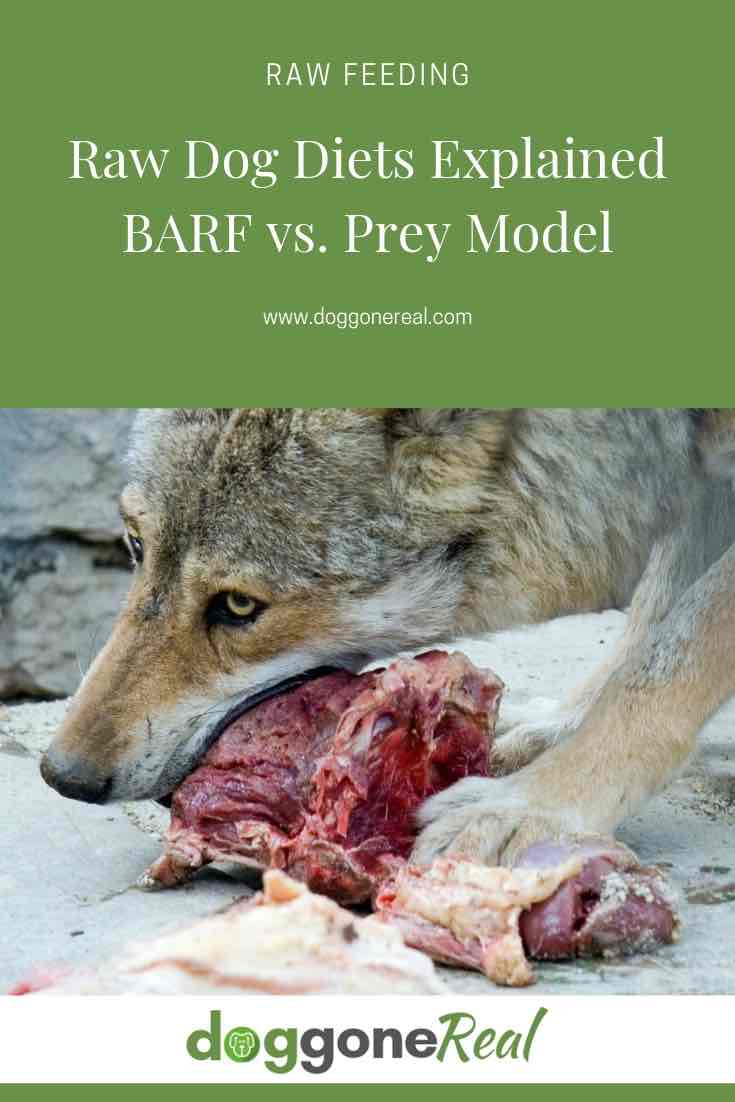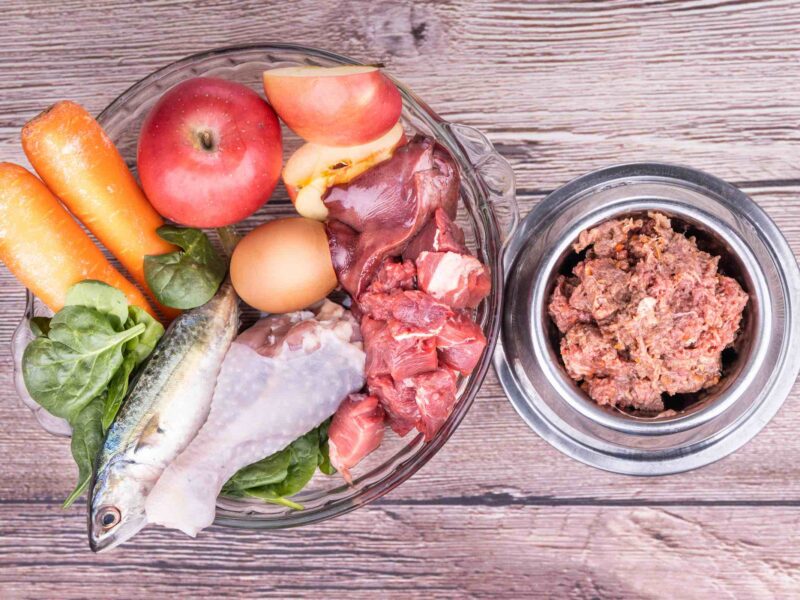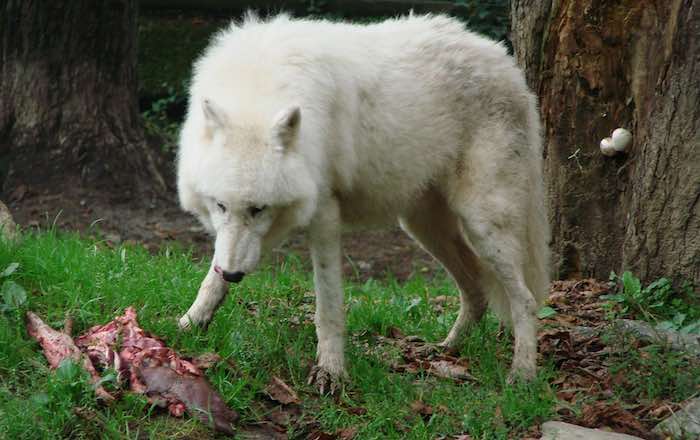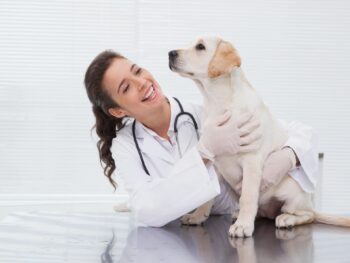In This Article
The Raw Dog Diet – BARF vs Prey Model
There’s a lot of controversy over which is better, the BARF vs Prey model of raw feeding. We’ll discuss both raw feeding models and share our thoughts after much study and experience with our own beloved dogs. These are our opinions, and I invite you to experiment and see which model best nourishes and pleases your dog.
First, let’s understand how similar dogs are to their wolf ancestors. Then we’ll look at what wolves eat in the wild.
Dogs Resemble Their Wolf Ancestors
Biologist Robert Wayne examined the DNA of 7 breeds of dogs and 26 grey wolf populations. It was determined that dogs are different than wolves by only 0.2%. That’s 2/10’s of 1%! Comparatively, dogs differ from coyotes by 4% which is the same difference between man vs. chimps. Discussions of his studies can be found here.
So despite their appearance and diversity, dogs are still wolves. And, as a result, the dog diet should not be very different than the wolf diet. The premise of a raw diet/primordial diet is that dogs should be fed what their ancestors enjoyed. If we understand what wolves eat in the wild this will aid us with what dogs should eat.
Wolves eat whole, wild prey with fur, feathers, feet, organs, and glands. This is nutritionally complete. Wolves are also known to eat berries and other vegetation when meat is hard to come by. This is beneficial as there are health benefits to the other nutraceuticals that the fruits and vegetables carry.
That said, let’s compare the various raw feeding models.
Prey Model Raw Diet
The Prey model replicates the diet of a wild canine of feeding on whole prey. However, the prey model does not require your dog to actually hunt and kill wild prey. Key points of difference:
- The prey model feeds whole prey and includes eating the fur, feathers, feet and all (which might be a bit much for some).
- It eliminates all processed foods and grains.
- Prey Model feeders are of the opinion that fruits and vegetables are filler foods that dogs don’t need. I’m not one to argue with them. There is plenty of research that supports both sides, so our humble suggestion is to try both raw feeding models. See which one your dog prefers and if you notice a difference in its health and vitality.
Followers of the Prey Model have valid points in their position that dogs, whose stomachs are highly acidic in order to protect them against bacteria and other pathogens found in raw meat, should promote a strongly acidic internal environment for ideal digestion and safety.
The pH of dogs gut when fed raw is 2.0 which is acidic. But, if fed kibble and starch the dog’s stomach pH will become more alkaline and inhibit proper bone digestion and allow for bacteria to exist.
Prey Model Raw Dog Food Diet Percentages:
The following proportions may vary slightly:
- 80% – raw muscle meat – often still on the bone
- 10% – raw, edible meaty bones – puppies need more calcium so 15% is recommended
- 10% – organ meat with 1/2 being liver
To Summarize the Prey Model Raw Diet
- Adheres to strict guidelines focusing on foods that dogs would eat in the wild
- Includes whole wild prey or as close to whole prey as possible
- No fruits and vegetables
- No dairy
- Limits supplements
The Franken Prey Model Defined
This raw feeding model adheres to the same strict guidelines as the Prey model. However, the “Franken Prey” diet assembles various parts from different animals and combines them in a way which over time will simulate a whole prey diet.
The BARF Model Defined – What is BARF?
The rather unappetizing acronym BARF stands for “biologically appropriate raw food”. It also refers to “bones and raw food.” Key points of difference:
- BARF provides dogs with a homemade raw diet.
- The diet consists of raw meat and bones as well as vegetables, fruits, and dairy.
- BARF eliminates all processed foods and grains.
- Supplementation is acceptable.
People new to raw food may appreciate that the BARF Model is much less restrictive than the Prey Model.
The BARF Diet Percentages:
The following proportions may vary slightly:
- 70% raw muscle meat – often still on the bone
- 10% – raw, edible meaty bones – puppies need more calcium so 15% is recommended
- 10% – organ meat with 1/2 being liver
- 10% fruits and vegetables
- Supplemented by additions such as raw eggs, plain yogurt, and/or healthy fats like coconut oil
As mentioned, the BARF model raw diet includes fruits and vegetables, and other food sources that some people don’t believe dogs need. But I personally lean toward this diet.
It’s my belief and experience that dogs benefit from the vitamins, minerals, phytonutrients, disease-fighting antioxidants and omega-3 fatty acids in wholesome fruits and greens. These boost immune system function and provide fiber and enzymes for more rapid evacuation of waste and toxins.
Fruit and Vegetable Guidelines
- If you choose the BARF model, it’s important to note that fruits and vegetables should never become a large portion of your dog’s diet.
- It’s also important to select the appropriate fruits and vegetables that are healthy and safe for dogs and prepare them in a manner that allows for optimal nutrition absorption.
- Dog’s don’t have the teeth, jaw structure, or salivary enzymes to begin the digestion process in the mouth. That said, if you choose to add fruits and vegetables to your raw dog diet it’s best to puree, steam, or ferment them to ensure the best nutrient absorption.
To Summarize the BARF Model Raw Diet
- Contains meat products
- Is more accepting of including ground raw meat products, considered by some to be easier to feed
- Contains acceptable fruits and vegetables
- May contain dairy products
- Does not necessarily contain “whole prey”
- May include supplementation to offset nutritional deficiencies caused by lack of eating fur, feathers, etc.
- Is much less restrictive than the Prey Model and may be easier to feed for those that are new to raw feeding
- Variety is key with all raw diets and the balanced diet can be achieved over time (2-4 weeks) vs. achieving a completely balanced diet on a daily basis.
How to Decide What Raw Feeding Model is Right for You and Your Dog
We at Doggone Real suggest you evaluate both the BARF vs Prey model and pick a raw feeding model that makes the most sense to you. Then, see how your dog performs after a few months. If you find your dog has gas, evacuation or breath issues after it has had ample time to adjust to the new diet, try the other model. Dogs, like people, are different in what they prefer and what they can digest easily.
Whichever model you start with, BARF vs Prey, you’ll likely find rapid improvement in your dog’s vitality, weight, and lust for eating, so you can’t really go wrong either way. Both options are better than processed dog food. What dogs DON’T need are grains, beans, legumes (like peanuts and peanut butter – sorry, Fido!) and other dangerous and/or empty foodstuffs.
Other Raw Feeding Resources:
The Ancestral Link & Why Raw Feeding is What Your Dog Wants Naturally
Benefits of Raw Dog Food – Why Raw Feeding is Better
5 Easy Ways for Transitioning Dog to Raw Diet
40 Fruits and Vegetables Dogs Can Eat and Can’t Eat
Top Raw Feeding Resources – My Go-to Favorites
PIN IT








 Watermelon Dog Treat Recipe – How to Make Frozen Dog Treats
Watermelon Dog Treat Recipe – How to Make Frozen Dog Treats